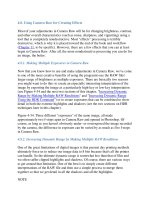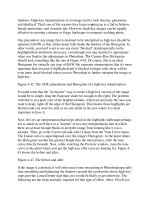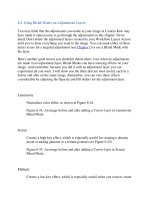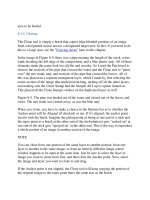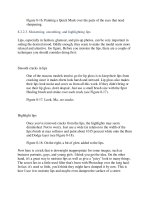Professional Information Technology-Programming Book part 4 potx
Bạn đang xem bản rút gọn của tài liệu. Xem và tải ngay bản đầy đủ của tài liệu tại đây (25.15 KB, 8 trang )
1.4. Winnowing Your Shoot
Photographers who are moving from film to digital are fast learning that they have
to establish a whole new routine for what used to be called "initial editing." To
distinguish it from the simple business of looking at slides and negatives on a light
table and throwing out anything that isn't worth keeping, that process has acquired
a new trade namewinnowingwhich encompasses the following:
Organizing and regrouping
Photos that are closely related or that show a time sequence should have
their thumbnails moved next to one another. These days, that process is
called Lightableing. You should do the same to all photos of the same
subject that were shot in the same location, lighting condition, and cropping.
This results in arranging photos into what I call sequences. You do this to
automate the basic processing of whole groups of images at one time and to
batch rename and add metadata to whole groups of files at one time.
Renaming
Once images have been grouped into sequences, you can use the Batch
rename command to add an abbreviation that indicates the subject of that
sequence, such as "red dress cu." You can then Batch rename the entire
sequence.
Adding metadata
You will want to add metadata such as copyright information and descrip
tive
keywords. Once entered, metadata stays with the file as it is copied and
manipulated. This way it's easier to prove copyright or find and collect files
that belong to a particular group or category.
Ranking the images
You are able to rank images with a star rating. It then becomes possible to
show only those images that have a minimum or better ranking.
NOTE
In Chapter 3, we'll go through how to do most of these tasks using Adobe Bridge.
The Appendix touches on some of the new software alternatives for this phase of
the workflow, including Adobe Lightroom.
1.5. Backing Up Originals
This is the time to copy all the files you've named and ranked to external media so
that you have the means to recover if something should happen to your original
file. For the sake of speed and efficiency, I suggest you purchase and install an
external hard drive and make your first copy to that drive. You should also have a
second drive stored someplace away from your main property. At regular intervals
(say twice a week), bring in the second drive and copy the contents of the first
drive to it so that you end up with two identical hard drives full of data.
For the sake of portability, I also suggest that you immediately copy your originals
to optical media. Not only do you have the added insurance of yet another backup,
but you can take images with you if you want to work on a laptop on the road or
need to make copies of files to send elsewhereespecially if you want to send your
advanced processing to an outside facility.
1.6. Presentation for Client Approval
Once you have your images adjusted to the point where they are at least
presentable to the client, you should be aware of a couple of further considerations.
First, if it's a portrait, fashion, or product shoot, consider w
hether you can get away
without retouching before you present. Second, you will have to decide how you're
going to make the presentation. You didn't think Photoshop was going to give you
only one choice, did you?
1.6.1. Retouching for Client Approval
First, regarding retouching, there are two more problems: retouching can be
destructive and, although there are ways to retouch nondestructively, they can't be
done in Camera Raw. Then, of course, there's the fact that retouching can be one of
the most time-
consuming facets of image processing. Next, you have to realize that
the glamorization of the subject is the whole point of the three disciplines of
photography that I mentioned above: fashion (including glamour), portraiture, and
product photography. You shouldn't present the image in less than its best form.
That's a bummer, because otherwise you can simply create all the presentation
formats directly from your RAW files. The compromise I make is to retouch the
shot I'd most like to see chosen and then make it clear in the presentation that this
is how all the images in that series would look, should one of them be chosen. So I
save that shot as a Photoshop file before I put the images into the presentation and
use only the Healing and Clone tools that will put their retouching strokes on a
blank layer. You'll find the steps for doing this in Chapter 8.
On rare occasions, I may use other tools if it's the only way to sell the client, but
even then retouching is all done on a copy of the main subject layer (usually the
Background layer). Once again, Chapter 8 will outline most types of retouching
that will be needed. The reason it's mentioned so late in the book is due to the
extreme potential for destruction in retouching, which dictates that it be placed as
far along as possible in the workflow to eliminate repeating other steps if you need
to make a revision. So just remember that there's a very good chance you'll want to
delete this retouching later in the process and that you'll have to do it all over
again. It won't be as painful if you avoid doing any more than is necessary this
early in the game.
1.6.2. Presentation Options
As I said, Photoshop CS2 gives you many options for presenting a shoot to the
client. Most of these methods have other uses as well. All are discussed thoroughly
in Chapter 12 since many of these tools are also tools for presenting your work in
its final form on electronic media or on the Web.
Contact sheets
Contact sheets have have the advantage of being very quick and easy for a
client to physically mark the chosen images with a marker. Images are also
automatically rotated to be vertical or horizontal, according to how they've
been rotated in Bridge. Also, the images can be passed around for a
committee vote without requiring each participant to have a computer. (Of
course, these days, most anyone likely to be voting will have a computer.)
Finally, you can email a JPEG of the finished contact sheet files and the
client can then print as many copies as are needed to pass around the office.
You can see a finished contact sheet in Figure 1-4. (See Chapter 12 to learn
how to create contact sheets.)
Figure 1-4. A finished contact sheet.
Galleries
Galleries are similar to the multiple-image Camera Raw view or the
Slideshow mode of Bridge. That is, thumbnails of each image are shown on
one side of the gallery, while a larger preview image appears on the other
side whenever you click on a thumbnail. Chapter 12
discusses the particulars
of how to create and prepare your images for a web gallery.
Photoshop's built-in galleries, along with a few that are available from
www.adobe.com, are the easiest to incorporate into your workflow. However,
almost all image editing and image management programs also automatically
create galleries from a folder and, generally speaking, the designs are all different
from one another. I know photographers who have collected half a dozen or so
third-party programs that they use primarily for creating galleries.
NOTE
All the automatically created galleries are editable in any HTML editor. So if you
don't like the style, you can always open the gallery in Adobe Go Live or
Dreamweaver and redesign it interactively.
PDF presentations
If you're still in love with the tradition of inviting the client over for a live
slide show, this is the way to do
it. The advantage is that the audience gets to
chime in all at once and it's easy to have the conversation bounce around
among art director(s), client reps, photographers, and assistants. The big
downside is that there's no way to put the image's filename on screen so it
can be noted. Furthermore, there's no equivalent to taking the slide out of the
projector to give to the photographer as a sign of approval. The potential
versatility of PDF documentsthey can be read on most computers and over
the Internetholds a lot of promise. Unfortunately, the potential is limited.
You'd be better off hooking up an LCD projector to your laptop and running
a web gallery from a CD as a means of running a slide show.
1.7. Preliminary Editing
Now we come to the point in
this book where the workflow of Photoshop editing
and manipulation begins to take place. There are two main stages in this workflow:
Camera Raw and Photoshop.
1.7.1. Editing Stage 1: Camera Raw
Before you get into Photoshop, make sure you've done everything possible in
Camera Raw to give yourself a good foundation. Remember, everything you do in
Camera Raw is nondestructive, so you want to do as much as possible before you
move on. You want to make your image look as gorgeous as you can in regard to
color balance, dynamic range, cropping and leveling, lack of fringing and noise,
and controlling contrast within specific ranges of Brightness with the new Curves
tab.
If you don't mind spending the money and taking the time to work outside of
Photoshop, you might want to do even more on your RAW files with a third-party
application such as Phase One Capture One or Pixmantec Raw Shooter Premium.
The Camera Raw workflow is covered in Chapter 4.
1.7.2. Editing Stage 2: Photoshop CS2
As amazing as Camera Raw is, it just doesn't do everything you might want to do.
Rather than list all the things it doesn't do, I'll just list the things you'll most likely
want to do in the most constructive and efficient order:
Adjustment Layers
Use to do overall image corrections on all the layers beneath that layer.
Masked Adjustment Layers
Use when you want an adjustment to apply only to a preselected portion of
the image.
Clipping Layers
Use for an Adjustment Layer that affects only one layer below or selected
layers. Masked layers can be clipped, too.
Merged Copy Layers
Use for applying destructive processes, such as filters (including knockouts,
filters, and destructive adjustments) and certain types of retouching.
Destructive adjustments are those that don't work as adjustment layers and,
therefore, make significant changes to the image when applied.
Transparent Layers
Use for retouching and compositing.
Duplicate the image when you must convert from 16-bit to 8-bit mode
That way, you can always go back to make changes in the 16-bit mode.
Also, add "8b" to the end of the filename. You should assume that all the
other images were output from Camera Raw to 16-bit mode, where you'd
have the most adjustment latitude.
By following the steps above in order, you will easily locate the point where you
made a revision to your image. Moreover, you're working from the place where the
adjustment affects more of the overall image to the place where it affects lessat
least until you get past the point of using Adjustment Layers. You are basically
turning off layers from the top down. When you get to the point where your image
is free of any content or characteristics you don't want it to have, stop and start
building new layers.
Now here's the really good part. You can keep the old layers, group them
into a set
or sets, and then turn off the set. Then, if you want to show yourself or an art
director the difference between one version of the image and others, you just turn
the layer sets on and off. This allows you to display whole ranges of interpretat
ions
of an image without ever having to change images. The specific tasks you'll do
during this phase are covered in Chapters 5 through 11.





